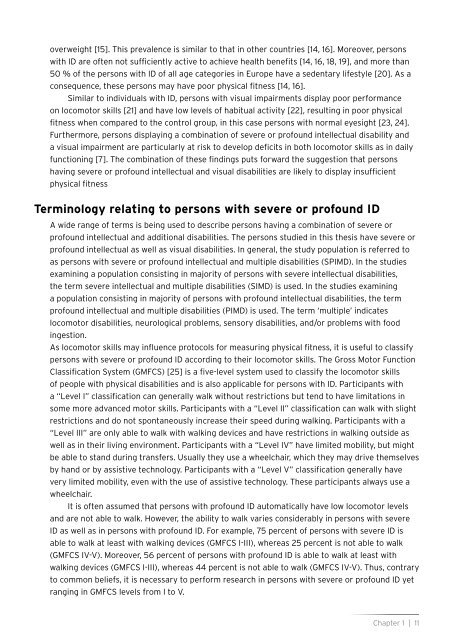Measuring physical fitness in Persons with Severe/Profound ...
Measuring physical fitness in Persons with Severe/Profound ...
Measuring physical fitness in Persons with Severe/Profound ...
- No tags were found...
Create successful ePaper yourself
Turn your PDF publications into a flip-book with our unique Google optimized e-Paper software.
overweight [15]. This prevalence is similar to that <strong>in</strong> other countries [14, 16]. Moreover, persons<strong>with</strong> ID are often not sufficiently active to achieve health benefits [14, 16, 18, 19], and more than50 % of the persons <strong>with</strong> ID of all age categories <strong>in</strong> Europe have a sedentary lifestyle [20]. As aconsequence, these persons may have poor <strong>physical</strong> <strong>fitness</strong> [14, 16].Similar to <strong>in</strong>dividuals <strong>with</strong> ID, persons <strong>with</strong> visual impairments display poor performanceon locomotor skills [21] and have low levels of habitual activity [22], result<strong>in</strong>g <strong>in</strong> poor <strong>physical</strong><strong>fitness</strong> when compared to the control group, <strong>in</strong> this case persons <strong>with</strong> normal eyesight [23, 24].Furthermore, persons display<strong>in</strong>g a comb<strong>in</strong>ation of severe or profound <strong>in</strong>tellectual disability anda visual impairment are particularly at risk to develop deficits <strong>in</strong> both locomotor skills as <strong>in</strong> dailyfunction<strong>in</strong>g [7]. The comb<strong>in</strong>ation of these f<strong>in</strong>d<strong>in</strong>gs puts forward the suggestion that personshav<strong>in</strong>g severe or profound <strong>in</strong>tellectual and visual disabilities are likely to display <strong>in</strong>sufficient<strong>physical</strong> <strong>fitness</strong>Term<strong>in</strong>ology relat<strong>in</strong>g to persons <strong>with</strong> severe or profound IDA wide range of terms is be<strong>in</strong>g used to describe persons hav<strong>in</strong>g a comb<strong>in</strong>ation of severe orprofound <strong>in</strong>tellectual and additional disabilities. The persons studied <strong>in</strong> this thesis have severe orprofound <strong>in</strong>tellectual as well as visual disabilities. In general, the study population is referred toas persons <strong>with</strong> severe or profound <strong>in</strong>tellectual and multiple disabilities (SPIMD). In the studiesexam<strong>in</strong><strong>in</strong>g a population consist<strong>in</strong>g <strong>in</strong> majority of persons <strong>with</strong> severe <strong>in</strong>tellectual disabilities,the term severe <strong>in</strong>tellectual and multiple disabilities (SIMD) is used. In the studies exam<strong>in</strong><strong>in</strong>ga population consist<strong>in</strong>g <strong>in</strong> majority of persons <strong>with</strong> profound <strong>in</strong>tellectual disabilities, the termprofound <strong>in</strong>tellectual and multiple disabilities (PIMD) is used. The term ‘multiple’ <strong>in</strong>dicateslocomotor disabilities, neurological problems, sensory disabilities, and/or problems <strong>with</strong> food<strong>in</strong>gestion.As locomotor skills may <strong>in</strong>fluence protocols for measur<strong>in</strong>g <strong>physical</strong> <strong>fitness</strong>, it is useful to classifypersons <strong>with</strong> severe or profound ID accord<strong>in</strong>g to their locomotor skills. The Gross Motor FunctionClassification System (GMFCS) [25] is a five-level system used to classify the locomotor skillsof people <strong>with</strong> <strong>physical</strong> disabilities and is also applicable for persons <strong>with</strong> ID. Participants <strong>with</strong>a “Level I” classification can generally walk <strong>with</strong>out restrictions but tend to have limitations <strong>in</strong>some more advanced motor skills. Participants <strong>with</strong> a “Level II” classification can walk <strong>with</strong> slightrestrictions and do not spontaneously <strong>in</strong>crease their speed dur<strong>in</strong>g walk<strong>in</strong>g. Participants <strong>with</strong> a“Level III” are only able to walk <strong>with</strong> walk<strong>in</strong>g devices and have restrictions <strong>in</strong> walk<strong>in</strong>g outside aswell as <strong>in</strong> their liv<strong>in</strong>g environment. Participants <strong>with</strong> a “Level IV” have limited mobility, but mightbe able to stand dur<strong>in</strong>g transfers. Usually they use a wheelchair, which they may drive themselvesby hand or by assistive technology. Participants <strong>with</strong> a “Level V” classification generally havevery limited mobility, even <strong>with</strong> the use of assistive technology. These participants always use awheelchair.It is often assumed that persons <strong>with</strong> profound ID automatically have low locomotor levelsand are not able to walk. However, the ability to walk varies considerably <strong>in</strong> persons <strong>with</strong> severeID as well as <strong>in</strong> persons <strong>with</strong> profound ID. For example, 75 percent of persons <strong>with</strong> severe ID isable to walk at least <strong>with</strong> walk<strong>in</strong>g devices (GMFCS I-III), whereas 25 percent is not able to walk(GMFCS IV-V). Moreover, 56 percent of persons <strong>with</strong> profound ID is able to walk at least <strong>with</strong>walk<strong>in</strong>g devices (GMFCS I-III), whereas 44 percent is not able to walk (GMFCS IV-V). Thus, contraryto common beliefs, it is necessary to perform research <strong>in</strong> persons <strong>with</strong> severe or profound ID yetrang<strong>in</strong>g <strong>in</strong> GMFCS levels from I to V.Chapter 1 | 11











